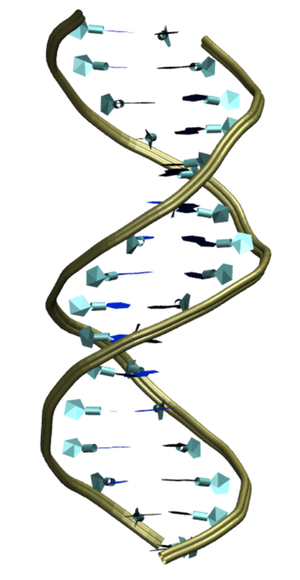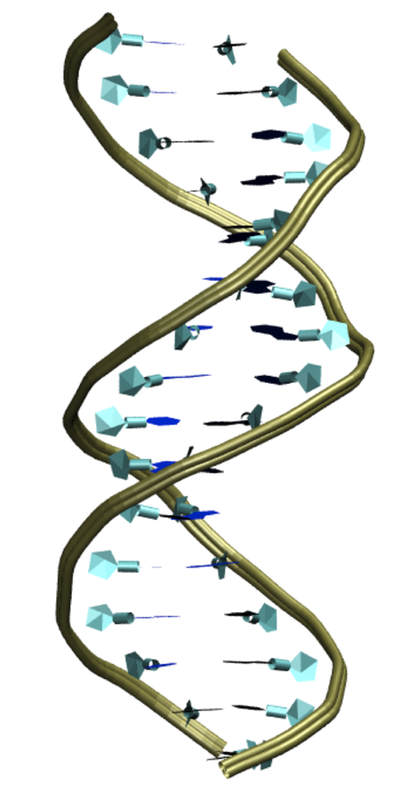DNA Flexibility at the Atomic Scale
A long stretch of DNA is resistant to bending, but experiments suggest that short DNA strands are much more flexible. Computer simulations reported in Physical Review Letters explore how the mechanical properties of DNA change as its length is systematically varied. The work shows that the stiffness depends sensitively on molecular length until this length exceeds a single turn of the double helix. The results start to reveal just how nature softens short stretches of DNA, the length scale that is most relevant for its function inside cells.
DNA is deformed when some proteins bind to it or when it gets wrapped up in chromosomes, so researchers believe that it has probably evolved to be not-too-stiff at these short scales. Recent experiments have demonstrated a “softening” (reduced stiffness) for some shorter strands, but Agnes Noy and Ramin Golestanian of the University of Oxford wanted to know how this softening comes about at the atomic level. They used computer simulations to investigate DNA lengths ranging from just a single base pair (a pair of DNA “letters”) to four turns of the double helix (over base pairs). The researchers allowed the ordinary random jiggling of atoms at room temperature to stretch, bend, and twist the molecule, and they analyzed this motion to deduce the mechanical parameters. They found that these parameters depend on the molecule’s length in ways that were hard to predict.
For example, the stretching stiffness first increases as the helix gets longer, but then after a maximum at half a helical turn it decreases again. Noy and Golestanian don’t have a complete explanation for this behavior. But they believe that the softening that occurs for shorter DNA lengths is associated with “cooperative” motions, where base pairs move in a coordinated way rather than jiggling completely independently. The team identified two important oscillation “modes” for stretching: one involving lots of motion at the ends of the strand and another where the two intertwined helices move in opposite directions (see videos). Such coordinated action can lead to a reduced stiffness because it generates more large-scale motion than would base pairs deforming independently.
The team’s results are consistent with recent experiments in which small-angle x-ray scattering was used to measure fluctuations in the length of roughly 40-base-pair-long DNA fragments [1]. In that case the DNA seemed ten times more stretchable than in previous experiments on longer chains. The new results predict this reduced stiffness for such short lengths, says Golestanian.
Noy and Golestanian found that DNA can also be twisted rather easily for lengths less than about base pairs (half a turn of the helix), but it becomes more resistant to twisting above this length. They are still investigating the origin of this phenomenon.
The simplest “elastic” model of DNA assumes that it acts like a regular spring or rod—the force needed to stretch or bend it increases in proportion to the amount of deformation. Golestanian says the results show that this elastic behavior of DNA applies “even at short and medium scales, provided we take care in defining length-scale-dependent elastic constants.”
Such complexity of DNA mechanics isn’t surprising, according to physicist Philip Nelson of the University of Pennsylvania in Philadelphia. DNA has a complicated architecture, with stacked base pairs weakly linked by hydrogen bonds, and a double helix that can switch between different conformations. This structure provides many ways to bend and flex at short scales, while these motions average out at longer scales to produce length-independent elastic behavior.
The short and medium scales are the most relevant to the contortions DNA must undergo in cell biology, so they matter, says Nelson. “The race is on to find what’s really going on at this difficult, but important, mesoscopic length scale.” He feels that the methods of Noy and Golestanian “set the stage for such questions.”
–Philip Ball
Philip Ball is a freelance science writer in London. His latest book is How Life Works (Picador, 2024).
References
- R. S. Mathew-Fenn, R. Das, and P. A. B. Harbury, “Remeasuring the Double Helix,” Science 322, 446 (2008)





